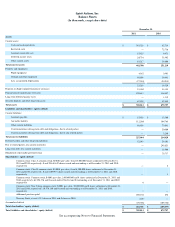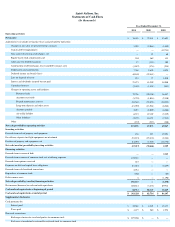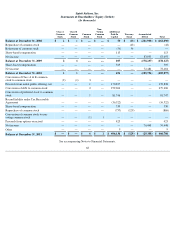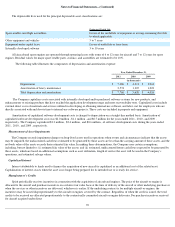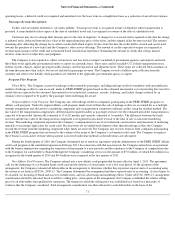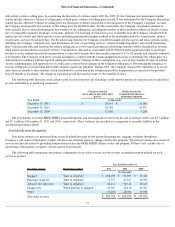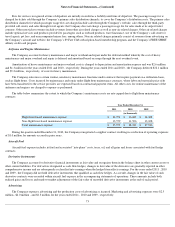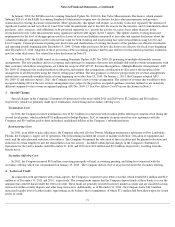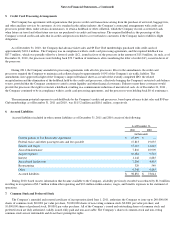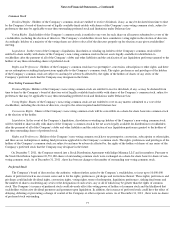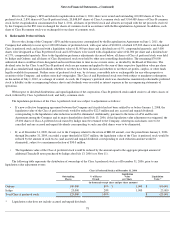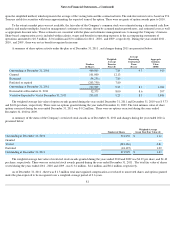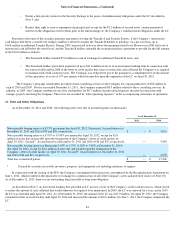Spirit Airlines 2011 Annual Report Download - page 84
Download and view the complete annual report
Please find page 84 of the 2011 Spirit Airlines annual report below. You can navigate through the pages in the report by either clicking on the pages listed below, or by using the keyword search tool below to find specific information within the annual report.
Notes to Financial Statements—(Continued)
Income Taxes
The Company accounts for income taxes using the liability method. The Company records a valuation allowance to reduce the deferred tax
assets reported if, based on the weight of the evidence, it is more likely than not that some portion or all of the deferred tax assets will be not
realized.
Interest Expense
Related-party interest expense incurred during 2011 , 2010 and 2009 was $21.0 million , $44.6 million , and $39.3 million , respectively,
and consisted primarily of paid-in-kind interest on tranche notes due to related parties and preferred stock dividends due to related parties. Non-
related party interest expense during 2011 , 2010 and 2009 was $3.8 million , $5.7 million and $7.6 million , respectively.
Stock-Based Compensation
The Company recognizes cost of employee services received in exchange for awards of equity instruments based on the fair value of each
instrument at the date of grant. Compensation expense is recognized on a straight-line basis over the period during which an employee is
required to provide service in exchange for an award. Restricted stock awards are valued at the fair value of the shares on the date of grant if
vesting is based on a service or a performance condition. To the extent a market price was not available, the fair value of stock awards was
estimated using a discounted cash flow analysis based on management’s estimates of revenue, driven by assumed market growth rates, and
estimated costs as well as appropriate discount rates. These estimates are consistent with the plans and estimates that management uses to
manage the Company’s business. The fair value of share option awards is estimated on the date of grant using the Black-Scholes valuation
model. See Note 9.
Concentrations of Risk
The Company’s business has been, and may continue to be, adversely affected by increases in the price of aircraft fuel, the volatility of the
price of aircraft fuel, or both. Aircraft fuel was the Company’s single largest expenditure representing approximately 42% , 35% , and 31% of
total operating expenses in 2011 , 2010 , and 2009 , respectively.
The Company’s operations are largely concentrated in the southeast United States with Fort Lauderdale being the highest volume fueling
point in the system. Gulf Coast Jet indexed fuel is the basis for a substantial majority of the Company’s fuel consumption. Any disruption to the
oil production or refinery capacity in the Gulf Coast, as a result of weather or any other disaster or disruptions in supply of jet fuel, dramatic
escalations in the costs of jet fuel, and/or the failure of fuel providers to perform under fuel arrangements for other reasons could have a material
adverse effect on the Company’s financial condition and results of operations.
The Company’s operations will continue to be vulnerable to weather conditions (including hurricane season or snow and severe winter
weather), which could disrupt service, create air traffic control problems, decrease revenue, and increase costs.
Due to the relatively small size of the fleet and high utilization rate, the unavailability of one or more aircraft and resulting reduced
capacity could have a material adverse effect on the Company’s business, results of operations, and financial condition.
The Company has three union-represented employee groups that together represent approximately 52% and 50% of all employees at
December 31, 2011 and 2010 , respectively. A strike or other significant labor dispute with the Company’s unionized employees is likely to
adversely affect the Company’s ability to conduct business. Additional disclosures are included in Note 17.
In May 2011, the FASB issued Accounting Standards Update No. 2011-04, Amendments to Achieve Common Fair Value Measurement
and Disclosure Requirements in U.S. GAAP and International Financial Reporting Standards (Topic 820)—Fair Value Measurement (ASU
2011-04), to provide a consistent definition of fair value and ensure that the fair value measurement and disclosure requirements are similar
between U.S. GAAP and International Financial Reporting Standards. ASU 2011-04 changes certain fair value measurement principles and
enhances the disclosure requirements particularly for Level 3 fair value measurements (as defined in Note 18). ASU 2011-04 is effective for the
Company in the first quarter of fiscal 2012 and should be applied prospectively. The Company is currently evaluating the impact of ASU 2011-
04 on its financial position, results of operations, cash flows and disclosures.
74
2.
Recent Accounting Developments


